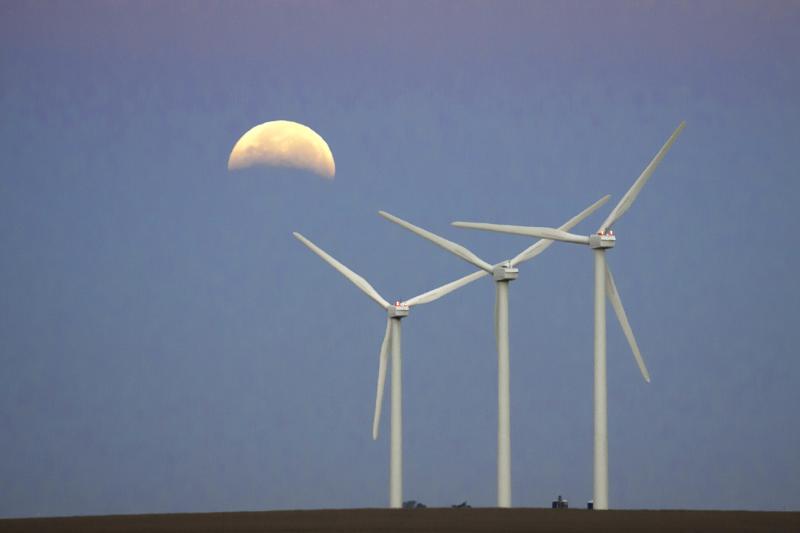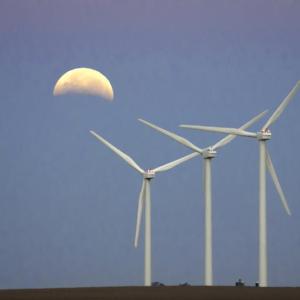New England Aqua Ventus Monhegan project a concern for fishermen
Boothbay region fishermen and community members are expressing concern over the New England Aqua Ventus project, a floating offshore wind turbine to be built two miles south of Monhegan. NEAV is a partnership between Maine Prime Technologies – a business arm of the University of Maine – and wind industry giants Diamond Offshore Wind, a subsidiary of Mitsubishi, and RWE Renewables.
UMaine’s Advanced Structures and Composites Center developed and patented the first-of-its-kind concrete-based floating hull and launched a one-eighth scale prototype of a two-turbine model off Castine in June 2013. The prototype became the first offshore wind turbine in the U.S. to be connected to a local power grid, according to penobscotbaypilot.com
Maine Aqua Ventus was formed as a limited partnership between UMaine, Emera and Cianbro and a general partnership was formed in December 2013. After a series of setbacks and with several partners entering and exiting, both Diamond Offshore and RWE entered with UMaine into NEAV in 2019.
NEAV’s mission is to trial a full-size turbine on the UMaine hull and, once the technology has proven itself, NEAV hopes to bring it to market, said NEAV spokesman Dave Wilby. NEAV has promised to keep manufacturing in coastal Maine; rights to the technology will remain with the university.
“Maine has chosen a deliberate and collaborative path toward deploying offshore wind, creating jobs in a new industry for Maine, and taking an important step toward seriously addressing climate change impacts already being felt,” said Wilby. “This course, charted by large bipartisan legislative majorities and the Mills Administration, means Maine is proactive in protecting the state's interests and values, while developing and building UMaine's patented floating turbine technology in Maine, by Mainers.”
Gov. Janet Mills signed a bill in 2019 directing Maine Public Utilities Commission to approve a 20-year contract between NEAV and Central Maine Power and, in 2020, Mills’ Energy Office proposed a 12-turbine array to be placed in federal waters 20-40 miles out to sea. In January, Mills signed a bill placing a 10-year moratorium, or ban, on offshore wind in state waters with the Monhegan project exempted, pledged a slower roll-out of the 12-turbine array project and created the Offshore Wind Research Consortium.
Maine Coast Fishermen’s Association Executive Director Ben Martens said MCFA believes there must be a comprehensive response to climate change, but that large-scale development in the Gulf of Maine is risky and there are cheaper, better proven and more immediate ways to produce carbon-friendly energy. He said the impacts on the ocean and ecosystem from this kind of development are unknown and it appears there is little money or effort going into understanding them. “100 years ago, we believed that hydropower and dams were the best way to produce renewable energy and now we are spending millions of dollars to remove those dams because the damage they have done to the environment does not justify the energy they create. Let's not make the same mistakes twice.”
Boothbay lobsterman Eben Wilson sits on the consortium panel which informs the Monhegan project and future array. He said the fishing community’s concerns include loss of fishing ground, how turbine or cable placement could affect sea life, and disruption of viewsheds.
“On a global scale, the U.S. is so behind on this technology it's crazy,” said Wilson. “But we have a lot to learn from people in the U.K. and their fishermen who have been bowled over and are now seeing huge effects because of offshore wind. It's shutting down fisheries ... When you look at it from the fishermen's standpoint, and you look at the proliferation of offshore wind in southern New England, the lease sites, you start to realize that large swaths of offshore bottom are going to get used for offshore wind … I wholeheartedly agree we have to change our energy structure, but no one is asking people to use less, they're just trying to find ways, develop technology so we can keep using more and not have to change our lifestyles. That’s a problem, too.”
The Monhegan test area is 1,384 acres and the apparatus will occupy a fraction of that. Some of that acreage lies inside the fishing-prohibited Monhegan Lobster Conservation Area, said Wilby. The hull will be anchored by moorings and a transmission cable will travel about 20 miles buried around six feet under the seabed to Bigelow Laboratory in East Boothbay. The cable will then travel underground to the Boothbay Harbor substation where it will connect to CMP’s regional grid. The cable landing was first proposed to Bristol and Port Clyde, but a town-wide vote in Bristol and code change in Port Clyde prevented NEAV from landing the cable.
Bigelow Lab President and CEO Deborah Bronk signed an easement with NEAV in May which allows the cable shore access and a corridor through the campus. Bronk said the decision is in line with the Lab’s mission to search for solutions in Maine and for the planet’s benefit, though the landing site will be the Lab’s only involvement with NEAV and wind power in general. The decision was not made lightly as the Lab works to support the working waterfronts and is aware of the concerns among fishermen about offshore wind, she said. “(The agreement) allows Bigelow Laboratory's property to be evaluated, and potentially selected, as a landing site for the power cable from the research turbine … New England Aqua Ventus has up to three years to make their decision, so we likely won't know for a while if the cable will actually come ashore on our campus.”
Bigelow Lab’s cooperation with NEAV is a concern to fishermen and should be a concern to the community because it seems to be a last-ditch effort, said Wilson. Since bringing the cable to the grid via overhead poles has proven hard in previous potential sites, running it underground limits Boothbay in any recourse to oppose the project, according to Select Board Chair Steve Lewis. Boothbay’s zoning ordinance would only permit the cable landing at the Bigelow Lab site or slightly further up the coastline where the only possible access is held by Washburn and Doughty, which declined to accept the cable, said Wilson.
“From a community standpoint, very few people know they're going to have to dig all the way from School Street to the substation in Boothbay Harbor. The state has done a very good job at utilizing only … utilities rights of way and they've systematically picked each one of them so there can be no conflict.”
Boothbay selectmen seem to have all but given up leveraging the town’s ability to change zoning laws and posture itself as a key player in the project’s future, Wilson said.
However, Lewis said Boothbay is powerless. “If it’s not above ground there really isn’t anything we can say about it. If it was above ground like it was going to be in St. George, well, that’s an aesthetic thing and if they were going to need access to town land or the poles, then we’d have a say. But they’re going to use utility rights of way and there really isn’t anything we can do at this point.”
Maine Department of Environmental Protection has yet to receive any applications for general offshore wind permits from NEAV. Boothbay Code Enforcement Officer Jason Lorrain also said he has received no applications from NEAV regarding the cable.
The Monhegan project’s skeptics also say the public should be questioning how the project will be funded long term. The 20-year contract between NEAV and CMP will likely result in higher rates to mitigate some of the project’s costs, according to Wilby. He said minimal increases in rates are an investment to unleash economic opportunity, showcase Maine ingenuity and prove offshore wind and fisheries can coexist. “(It’s) about how to position Maine as a first mover in this industry in the U.S. As has been the case with other power technologies, as more offshore wind projects are developed, the cost should drop significantly.”
Careful about how he raises his concerns, Wilson said he also fears fishermen being assigned the “climate denier” label when they are anything but. “It's a hard thing to talk about with people because anytime you raise questions, you open that door. I've heard it said many times, but I'm not. I just want to make sure we're doing this responsibly.”
Wilson said with all the untapped potential of land-based wind energy, solar and other forms of renewable energy, offshore wind needs to be a last resort if only to preserve what little fishable waters are left. When any ocean floor area is cordoned off to fishing, a vital resource is being denied to people who depend on it, so offshore projects in Maine are going to displace Maine fishermen, he said. “The ocean and its floor are a community-based structure … and now you're flipping it to a corporate-based structure and only one person gets to use it … The general public just doesn't have much of an opinion about this unless they have a dog in the fight. They think it's a cool thing, but they don't know how it might be affecting other people’s lives.”
What is one thing NEAV wishes its opponents could understand about the project which it feels is overlooked by many? Wilby responded, “Maine and Massachusetts have already determined that their climate goals cannot be met without offshore wind. With the Federal government planning to create numerous leases for Atlantic coast offshore wind projects, (it’s) coming to the Gulf of Maine, one way or the other. Maine being both proactive and deliberate by pursuing the demonstration project, and then a subsequent research array, is the state's best chance to influence how commercial offshore wind eventually comes to the Gulf … The (project and array) should really be understood as the best way to protect Maine’s fishing industry and interests in light of national and global events.”
Considering the momentum the Monhegan project has developed over the last couple years, Wilson said it has made his participation in the consortium pretty awkward, though he said communication has been at a standstill. With the one project practically set in stone, Wilson said he fears the precedent it might set for the future 12-turbine array and the little power fishermen on the consortium panel will have to pump the brakes.
“Now I sit on this panel and I'm being asked ‘How can we do this better’ even though I’m being told it's still going to happen … People have been telling me it's such a great opportunity to have a seat at the table, and I'm like, a seat at the table? For what? To tell them how to cut my throat better? Or how to cut it slower?”
Event Date
Address
United States

























